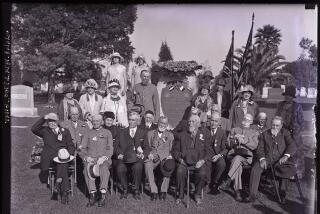Op-Ed: Kanye West’s ill-informed rants on slavery align alarmingly well with popular views of American history

Kanye West, the self-proclaimed “voice of this generation,” is now a bullhorn for bad history. His suggestion that 400 years of slavery (250 in North America) was somehow a “choice” made by the enslaved drew an immediate and fierce rebuttal from across the media landscape.
Kanye critics rightly point to the long and bloody history of slave rebellion in this country as proof that African Americans often made choices of a very different nature. Leaders such as Nat Turner knew that mutilation, torture and execution awaited in the likely event of their failure, yet they rose up against their masters nonetheless. Between 1619, when the first recorded shipment of kidnapped Africans arrived in North America, until 1865, when the whole regime came crashing down, hundreds of thousands of enslaved people fled from their plantations, risking all they had in order to escape a lifetime of bondage.
Yet there’s an uncomfortable truth in West’s comment. Ill-informed though his views may be, they align alarmingly well with popular interpretations of American history.
The claim that slaves somehow consented to their own enslavement is a Kanyefication of one of our most enduring national myths. Depicted in fiction, film and even statuary, the “loyal slave” has persisted for more than a century and a half. The trope buttresses the so-called Lost Cause school of history, an intellectual movement celebrating the plantation South and exonerating it from any blame for the Civil War. Instead, that cataclysm is charged to the North, which destroyed a civilization that benefited masters and slaves alike — so goes the logic of Lost Cause propagandists.
The Lost Cause myth of the loyal slave was an adaptation of an earlier motif in Southern writing. Against a rising tide of abolitionism in the 1830s, slaveholding apologists increasingly touted the benefits of their plantation system and the contentment of their enslaved workforce.
Some three decades later, when the war broke out, Confederate officials placed depictions of obedient, toiling slaves on their new currency. This was both a recognition of the importance of slave labor to the Southern economic system and an attempt to sanitize what that labor entailed.
The fiction of the loyal slave remains the great vindicator of the Lost Cause.
When the war ended and the South’s 4 million slaves were formally freed, those depictions multiplied and became imbued with nostalgia. In postbellum tributes, Southern writers recalled how faithful slaves fended off Yankee invaders and guarded the family valuables. Uncle Remus, the fictional slave narrator of Joel Chandler Harris’ famous Br’er Rabbit stories, even shoots a Union sharpshooter as the soldier descends on the family plantation. Conspicuously missing from any of these narratives were the 150,000 former slaves who enlisted in the Union army and took up arms against their former masters.
Southerners preserved the memory of their devoted slaves not only in literature but in marble and bronze as well. One of the best-known Confederate monuments, a 32-foot-tall pillar in Arlington National Cemetery erected in 1914, depicts a number of wartime scenes. In one, a rebel soldier kisses his child, who’s cradled in the arms of a slave “mammy,” while in another, a black man in Confederate uniform marches alongside white soldiers. The message here is clear: Slaves sustained the cause as the Confederacy mobilized for war.
A marble monument erected in Fort Mill, S.C., in 1895, is even more explicit. It depicts scenes of bucolic plantation life alongside an inscription to the “faithful slaves who, loyal to a sacred trust, toiled for the support of the army … and with sterling fidelity guarded our defenseless homes, women and children.”
The National Mall in Washington was nearly the site of a similar monument. In 1923, just months after the dedication of the Lincoln Memorial, the Senate authorized the construction of a statue “in memory of the faithful slave mammies of the South.” Due in part to substantial protest from the African American community, the House took no action on the bill, andthe monument was never constructed.
Portrayals of steadfast slaves took to an even bigger stage in 1939 with Hollywood’s plantation romance “Gone With the Wind.” Hattie McDaniel won an Academy Award for her role as Mammy, the doting house slave who cleaves to the O’Hara family through all the many trials of the war. It was a depiction that, perhaps more than any other, cemented the image of the loyal slave in the public consciousness.
Of course, Hollywood’s sympathies for slaveholders are a thing of the past, and Washington now hosts the National Museum of African American History and Culture. Yet old myths die hard. Two South Carolina legislators recently introduced a bill for a monument to the state’s black Confederate troops. That historians are unable to document the existence of a single black rebel soldier in South Carolina seems to matter little. Nor has it dissuaded like-minded mythologists from citing outlandish figures about black Confederates elsewhere in the South.
They do so because the fiction of the loyal slave remains the great vindicator of the Lost Cause. And, although many of their claims are rooted in fantasy rather than fact, Confederate apologists have been surprisingly successful in their efforts to sanitize and exculpate the plantation South. According to a 2011 poll, only 38% of respondents said they believe that slavery was the precipitating issue of the Civil War.
Defending himself against a wave of criticism, Kanye West insists that he was “presenting new ideas.” But, whether consciously or not, he simply repurposed a myth as old as the Civil War itself. The Lost Cause may have found its newest spokesman.
Kevin Waite is an assistant professor of history at Durham University in Britain. His forthcoming history of slavery and the Civil War in the American West will be published by the University of North Carolina Press.
Follow the Opinion section on Twitter @latimesopinionand Facebook
More to Read
A cure for the common opinion
Get thought-provoking perspectives with our weekly newsletter.
You may occasionally receive promotional content from the Los Angeles Times.










